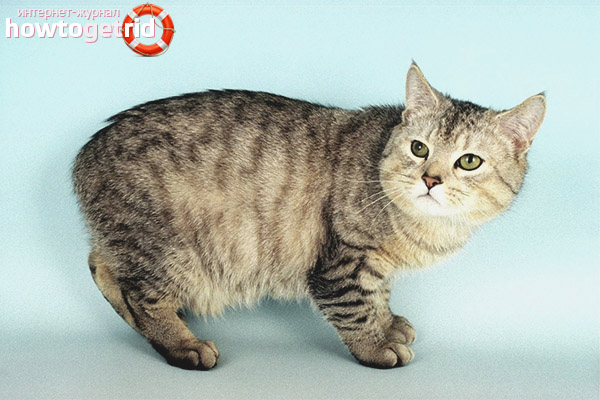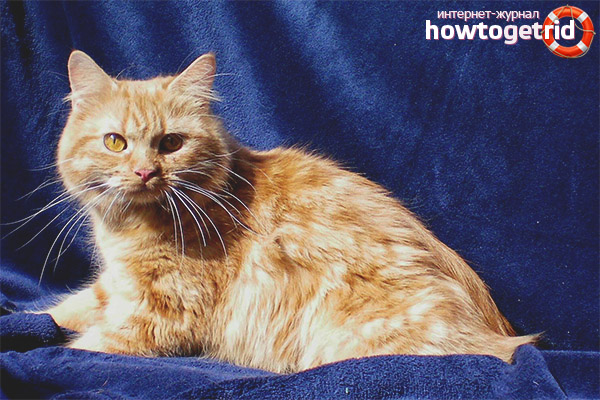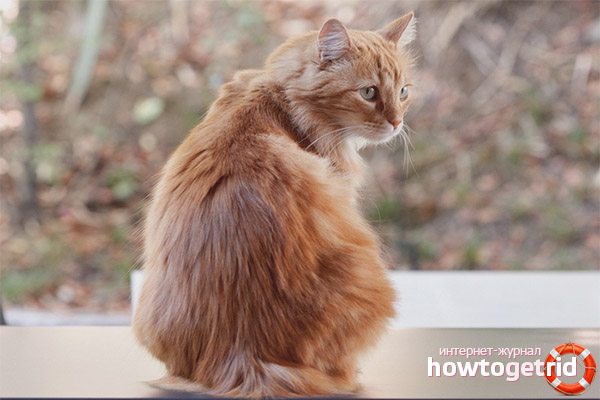The content of the article
Welsh cats or kimrik (longhair menx) are rare and very unusual representatives of the cat family. They belong to domestic tailless or short-tailed cats.
The history of the breed
The homeland of Welsh cats is considered to be the Isle of Man, located next to England. It is he who is the site of the appearance of all the Menskas, contrary to the opinion of Canadian breeders who consider themselves the authors of this breed.
Tailless cats were first mentioned in the 50th year of the 18th century. On the small island of Maine, subsequently, natural selection appeared animals with short tails or without them at all, which became the highlight of local cats. Sometimes litter menxes were present in the litter, but this was rather an exception and did not meet generally accepted standards. When in Canada in the 60s of the 20th century, a cat brought such kittens, they began to be allocated to another breed and bred accordingly.
Breed features
Kimrik is a medium-sized cat with a weight of about 5 kilograms. Breed standards for manx and kimriks differ only in long hair.
- Torso. By type of kobby, medium size, with a low line of the abdomen, short back, located on the same line from head to tail.
- Head. Round. Its width is slightly less than the length. It has an average size. The lines of the cheekbones are expressed. With a massive chin. Vibriss pillows are quite pronounced. The forehead has a rounded shape.
- Limbs. With developed muscles, strong, front shorter than the rear. Feet are medium in size with rounded pads. Bunches of wool are between the fingers.
- Eyes. Big size. Rounded shape. The outer corners are raised towards the ears from the side of the nose. Eye color directly depends on the color of the animal’s coat.
- Wool. It is medium or very long. The presence of a thick downy undercoat that is longer than the outer hair. Characteristics of the texture of the outer hair depend on the color of the cat and the time of year. On the muzzle and paws, the hair is shorter than on the body. The tassels on the ears make the face of Welsh cats especially cute and charming.
- Tail. Complete absence or very small, miniature cartilage.
Types of Welsh cat tails:
- A long tail is the exception rather than the rule. But the Cimriks also have it.
- Tail from one and a half to 8 centimeters in length.
- The most valuable cats of this breed have no tail at all. Even quite the opposite, in the place where the tail should grow - the pit.
Character Features
Cats of this breed are quite affectionate and like to play. Having powerful hind legs designed to balance the absence of a tail, they can jump perfectly, they can reach almost any height in the room.
Welsh cats have extraordinary intelligence. They quickly learn and can independently open doors and receive everything that they want. They have another habit that is more characteristic of dogs - to hide or bury things that are expensive for themselves.
Fact! Kimrick is not afraid of water. Most of all they like water treatments and entertainment.
Cats of this breed are not endowed with an expressive cat's voice, but they like to talk or purr cute, thus creating a dialogue with the owner. Like dogs, they are unusually attached to their master, they can find a common language with the child, as well as other pets living with them in the same territory. Despite the outward calm, kimriki are very companionable cats. It is difficult for them to remain alone with themselves.
Health and Maintenance
Genes that make both manxes and kimrikas have no tails can have an effect on the health status of cats. In the case when both parents are carriers of this gene, kittens can die before they are born. Having a gene from one of the parents, babies may suffer from Manx syndrome. In such animals, the spine may be split, as well as have other disorders. Congenital pathologies of the gastrointestinal tract and genitourinary system can occur.
Fact! As a rule, up to six months, birth defects make themselves felt. Therefore, do not buy a kitten up to 6 months of age. Kimriks usually live no more than 14 years old.
The Welsh cat, of course, is not distinguished by its luxurious and long tail, but there are nerve fibers in the place where it was supposed to be. This area in the animal is very sensitive. Therefore, you do not need to grab it by a piece of tail or "slap on a tailless pope." It can be very painful. When you want to raise the kimrika, you need to support it with the chest by one hand, and hold it with the other hand behind the legs, so as not to burden the spine.
Hygiene procedures are no different from those required by more tailed pets. They must be combed, approximately once every 3 days, and every day during moulting. Brush your ears and teeth - every 7-10 days. Sometimes bathe with special cat shampoo or baby fragrance free.
For the animal to go into the tray, and not past it, it must be in an accessible place and always be clean. It’s best to buy a special cat toilet at the pet shop, inside which a special basket is placed - thus, the cat’s paws and coat will always remain dry.
Welsh cat food should be balanced and of high quality. It should include all the necessary vitamins and minerals that are necessary to keep the pet's coat in good shape. Since the cat is quite active and mobile, its nutrition should be appropriate.
Attention! Kimrick is not a cat that is easy to breed. Even when absolutely healthy cats are crossed with high pedigree data, kittens are born that have many serious pathologies that are incompatible with life.
Possible colors
Kimriks can have different colors and patterns. The CFA organization considered the following standard color options:
- White blue-eyed cat.
- White cat with amber eyes.
- White cat with heterochromia.
- Silver chinchilla.
- Smoke on silver.
- Black, smoky blue.
- Silver.
- Red.
- Mackerel.
- Cakes.
- Tabby with white marks.
- Harlequin
- Solid: black, blue, red, cream.
It is considered to be considered non-standard: Himalayan, chocolate, lavender.
What is the price of a Welsh cat?
Where can I buy kimrika?
Quite an easy task. In the countries of the former Soviet Union, finding a certified cattery is quite problematic, and when buying purebred cats from private breeders, it is easy to run into scams. Unscrupulous sellers sometimes go to the trick in order to earn money on cute outbred kittens, stop their tails. Then they pass him off as police officers, kimriks and kurbobov.
You can buy kimrik only abroad, in a nursery with a good reputation. In this case, it is worth checking carefully all the documents and the seller’s reputation.
Video: kimrik cat breed












Submit